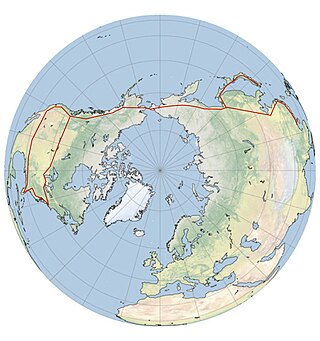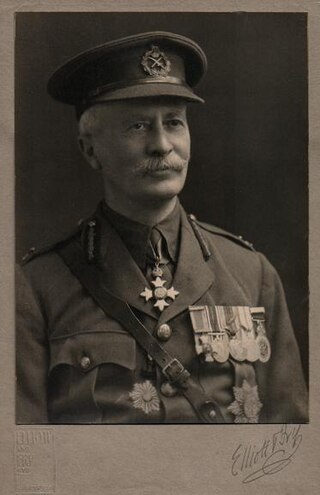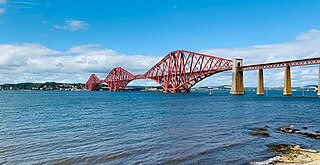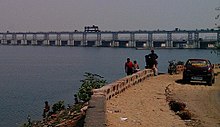
A tunnel is an underground or undersea passageway. It is dug through surrounding soil, earth or rock, or laid under water, and is usually completely enclosed except for the two portals common at each end, though there may be access and ventilation openings at various points along the length. A pipeline differs significantly from a tunnel, though some recent tunnels have used immersed tube construction techniques rather than traditional tunnel boring methods.

A Bering Strait crossing is a hypothetical bridge or tunnel that would span the relatively narrow and shallow Bering Strait between the Chukotka Peninsula in Russia and the Seward Peninsula in the U.S. state of Alaska. The crossing would provide a connection linking the Americas and Afro-Eurasia.

The East Central Railway is one of the 19 railway zones in India. It is headquartered at Hajipur and comprises Sonpur, Samastipur, Danapur, Pt. Deen Dayal Upadhyaya and Dhanbad divisions.
The Jammu–Baramulla line is a railway track between the towns of Jammu and Baramulla in Jammu and Kashmir, India. The 338 km railway track will connect the Kashmir Valley with Jammu Tawi railway station and thence to the rest of India. It comes under the jurisdiction of the Jammu Railway Division of Indian Railways's Northern zone. Part of this railway route from Udhampur to Baramulla is known as Udhampur-Srinagar-Baramula Rail Link (USBRL). The 359 m (1,178 ft) high Chenab Bridge lies on this line, which is the highest railway bridge in the world. The total project cost in 2022 was INR28,000 crore. Construction of the route faced natural challenges including major earthquake zones, extreme temperatures and inhospitable terrain.

The Godavari Bridge or Kovvur–Rajahmundry Bridge is a truss bridge spanning the Godavari River in Rajahmundry, India. It is India's fourth longest road-cum-rail bridge crossing a water body, the first one being the Bogibeel Bridge over the Brahmaputra in Assam, and second is Digha–Sonpur Bridge over the Ganga in Bihar.
Lingaraj Temple Road is a station located in Bhubaneswar.
A fixed link or fixed crossing is a permanent, unbroken road or rail connection across water that uses some combination of bridges, tunnels, and causeways and does not involve intermittent connections such as drawbridges or ferries. A bridge–tunnel combination is commonly used for major fixed links.

The Chenab Rail Bridge, the world's highest railway bridge, is a steel and concrete arch bridge carrying a single-track railway line, located between Bakkal and Kauri in the Reasi district of the Jammu Division of Jammu and Kashmir, India. The bridge spans the Chenab River at a height of 359 m (1,178 ft) above the river, making it the world's highest rail bridge and the world's highest arch bridge. The bridge was fully completed and was inaugurated in August 2022. It is built between the Sangaldan Railway Station and the Reasi Railway Station.

Brigadier-General William Thomas Clifford Beckett CBE DSO VD was a British railway engineer in India and a British Army officer.

The Godavari Arch Bridge is a bowstring-girder bridge that spans the Godavari River in Rajahmundry, India. It is the latest of the three bridges that span the Godavari river at Rajahmundry. The Havelock Bridge being the earliest, was built in 1897, and having served its full utility, was decommissioned in 1997. The second bridge known as the Godavari Bridge is a truss bridge and is India's third longest road-cum-rail bridge crossing a water body.

Vidyasagar Setu, also known as the Second Hooghly Bridge, is an 822.96-metre-long (2,700 ft) cable-stayed six-laned toll bridge over the Hooghly River in West Bengal, India, linking the cities of Kolkata and Howrah. Opened in 1992, Vidyasagar Setu was the first and longest cable-stayed bridge in India at the time of its inauguration. It was the second bridge to be built across the Hooghly River in Kolkata metropolitan region and was named after the education reformer Pandit Ishwar Chandra Vidyasagar. The project had a cost of ₹388 crore to build. The project was a joint effort between the public and private sectors, under the control of the Hooghly River Bridge Commissioners (HRBC).

Nehru Setu is a railway bridge across the Son River, connecting Dehri-on-Son and Son Nagar, in Bihar.

The Gaya–Pandit Deen Dayal Upadhyaya Junction section, formerly Gaya–Mughalsarai section , is a railway line connecting Gaya Junction and Pandit Deen Dayal Upadhyaya Junction. This 197-kilometre (122 mi) track is part of the Grand Chord, Howrah–Gaya–Delhi line and Howrah–Prayagraj–Mumbai line. This section includes Arrah-Sasaram and Son Nagar branch lines. It is under the jurisdiction of East Central Railway.

The Howrah–Chennai main line is a railway line connecting Chennai and Kolkata cutting across Eastern Coastal Plains of India. It covers a distance of 1,661 kilometres (1,032 mi) across, West Bengal, Odisha, Andhra Pradesh and Tamil Nadu.

The Bogibeel Bridge is a combined road and rail bridge over the Brahmaputra River in the northeastern Indian state of Assam between Dhemaji district and Dibrugarh district, which was started in the year 2002 and took a total of 200 months(16 years and 8 months) to complete, Bogibeel river bridge is the longest rail-cum-road bridge in India, measuring 4.94 kilometres over the Brahmaputra river. As it is situated in an earthquake-prone area it is India's first bridge to have fully welded steel-concrete support beams that can withstand earthquakes of magnitudes up to 7 on the Richter scale. It is Asia's second longest rail-cum-road bridge and has a serviceable period of around 120 years.
Frederick Thomas Granville Walton CIE, M. Inst C.E., Telford Medal, (1840-1925) was a British railway engineer in India. He specialised in bridge construction. He was commonly known by his middle name Granville, and was often referred to as Mr F.T.G. Walton. Walton was born in September 1840 in Hampton, Middlesex, England to William Walton (1795–1889) of Reading, Berkshire and Elizabeth Louisa Plunkett (1801–1866) originally of Dalston, Cumberland.

The Forth Bridge is a cantilever railway bridge across the Firth of Forth in the east of Scotland, 9 miles west of central Edinburgh. Completed in 1890, it is considered a symbol of Scotland, and is a UNESCO World Heritage Site. It was designed by English engineers Sir John Fowler and Sir Benjamin Baker. It is sometimes referred to as the Forth Rail Bridge, although this is not its official name.

Rail transport is an important mode of long-distance transportation in China. As of 2024, the country had more than 159,000 km (98,798 mi)[a] of railways, the 2nd longest network in the world. By the end of 2023, China had more than 45,000 kilometres of high-speed rail (HSR), the longest HSR network in the world.

Bhadrak railway station is a major passenger railway station serves Bhadrak district in Indian state of Odisha. It is situated on the howrah chennai main railline. It comes under (NSG3) railway stations category of India.
















